
Recently, much has been written about corporate culture, hybrid workforce, and flexible work hours. Changes in the workplace and how we physically are here to stay. A combination of sitting, standing, and walking effectively improves health.
For example, some companies will increase salaries to win the war for talent. In the U.S.A., recent research has shown that year-to-date salary increases will nearly double in 2022. Interestingly, the historical norm is an increase of 2%.
Also, the Conference Board, a New York-based think tank, indicates we’ll have the highest increase since 2008 this year. They predict a 3.9% increase in wage costs for firms, which includes pay for new hires. However, some companies that cannot increase wages reduce hours by implementing a 32-hour workweek with the same compensation.
Another effective technique in recruitment is skills-based hiring. Human resource leaders and other hiring decision-makers are beginning to change their assessment methods in hiring talent. Instead of putting so much weight on university degrees, more emphasis is on what precisely a candidate can do for our organization today.
How do we physically accomplish our daily tasks with these organizational changes? The physical location, workplace environment (corporate culture), and work hours are critical to productivity. But there’s more.
As we hire better and provide various venues (office, home, on the beach, etc.) to work from, it is also imperative that we address how we physically work. Our productivity and workplace satisfaction will suffer if our physical condition goes unchecked.
In this post, we will dive deeper into exactly how we physically work. Too much sitting is bad for our health. A combination of sitting, standing, and walking effectively improves health. And is the best way to accomplish our work. I feel a slight vibration on my wrist. I look down at my watch and see a colorful character stretching with the caption “Time to get moving!”
First, let’s cover the most used method for work or study, sitting at a desk. The dictionary definition of sitting is a bit humorous. According to Webster’s Dictionary, one purpose is “To rest on the buttocks.” In the U.S. military, they say, “Take seats.”
We have sat at work for many years and have been able to focus and be productive. However, there are problems with excessive sitting. The U.K. Chief Medical Officers’ Physical Activity Guidelines report recommends breaking up long periods of sitting time with activity for just 1 to 2 minutes. While historically, knowledge workers have sat on their buttocks to work, this practice has some health concerns. Mayo Clinic Research indicates links between sitting for long periods with several health concerns. Problems include obesity and increased blood pressure, high blood sugar and excess body fat around the waist, and abnormal cholesterol levels. Too much sitting overall and prolonged periods of sitting also seem to increase the risk of death from cardiovascular disease and cancer. Shorter sitting spells improve health.
So, if we must sit to work, here are a few practical tips to minimize the health concerns with sitting. There is no single body position that is preferred for sitting. Occasional changes in seat positions can be beneficial. Here are some tips from the Canadian Centre for Occupational Health and Safety.
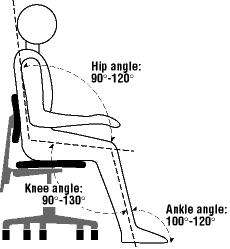
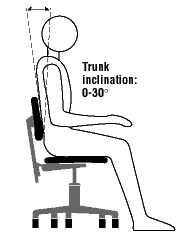
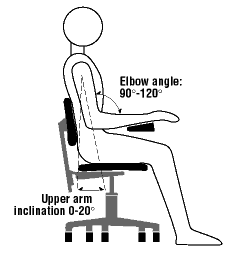
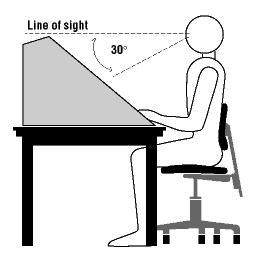
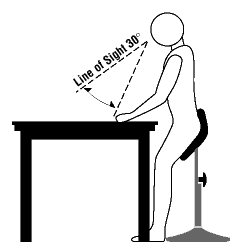
Alternatively, standing while working seems to provide excellent physical benefits. However, some studies have shown that there can be some adverse effects if one stands too long in the same position. These effects are sore feet, swelling of the legs, varicose veins, general muscle fatigue—low back pain, stiffness in the neck and shoulders, etc.
Workers can reduce comfort from sitting too much by standing for some of their work. Here are a few tips to consider:
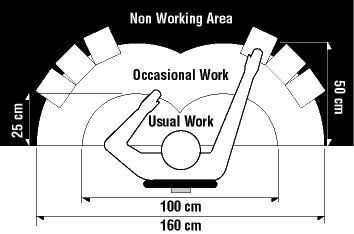
Finally, how about walking while you work? You know that you can sit and stand to work. How about walking? Well, we know that standing takes more energy than sitting. And walking takes more energy than standing. But can we walk and work all day? All the studies that I have read say no.
We know from various research that sitting at your desk all day is terrible for your health. Standing at your workstation for about 15 minutes out of an hour is recommended. Alternatively, a professor at the University of Waterloo suggests standing at least 30 minutes out of an hour. So, standing from 15 to 30 minutes during an hour seems to be the sweet spot. But how about walking for a portion of your sitting time?
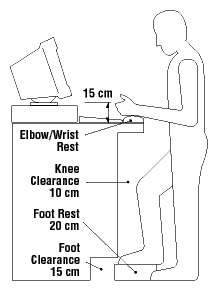
In a 2007 study, James Levine, from the Mayo Clinic’s campus in Scottsdale, Arizona, found that standing and walking at a treadmill desk while working can burn about 100 calories an hour more than sitting. He further revealed in March 2015 that over 12 months, participants increased their activity and lost weight. There were other health benefits, including lower cholesterol and triglycerides.
According to Jody Ensman, manager of the Health & Wellness program in the University of Kentucky’s H.R. Department “There are always risks in any physical movement and exercise.” She added, however, that treadmill-desk workstations are safe “as safe as any treadmill workout.” Her department provides some commonsense rules:
As your coworker has informed you from the lofty heights of their standing desk, sitting all day makes us sicker, fatter, and sluggish.
Research has shown that there are cognitive benefits to movement. More than 80% of people who participated in a 2014 Stanford University study “improved their creative output while walking.” Study participants who walked prior to solving a puzzle generated more creative solutions than sedentary participants and were better “divergent thinkers.” They examined the creativity levels of people while they walked versus while they sat. Also, a person’s creative output increased by an average of 60% when walking.
Julia Berman in SmartMeeting.com provides some exciting tips in this article entitled “How to Plan Your Walking Meeting.” I’ll list the 5 Main Benefits that she provides below. However, I suggest you read her article if you are serious about adding a walking meeting to your work regime.
Sitting with the correct posture is acceptable for work. However, if sitting at work is combined with 15 to 30 minutes in a standing position, it is even better. Finally, the best scenario is a combination of sitting, standing, and walking. Save your back.